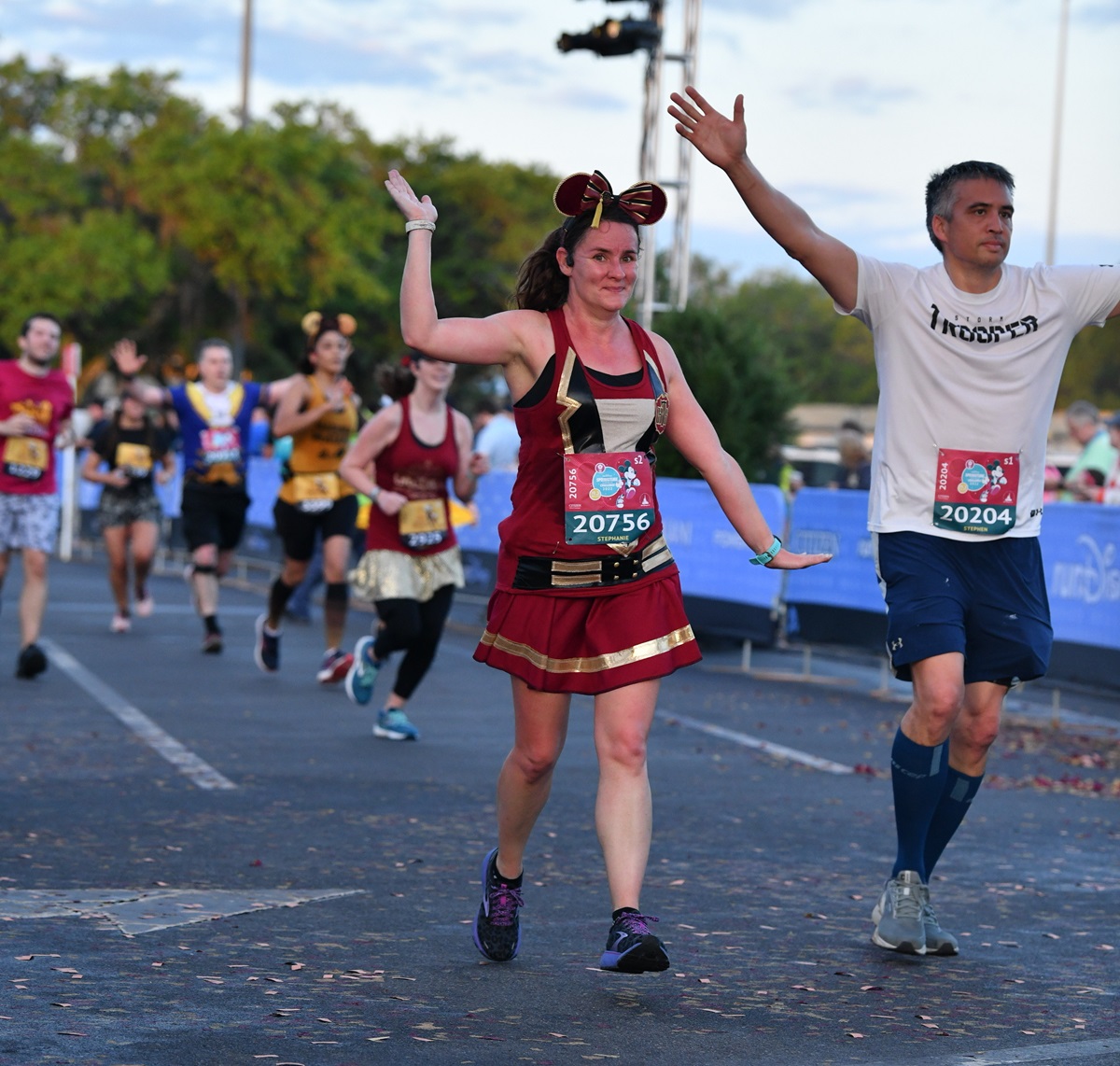The 10-mile distance is perfect for runners who want to go beyond a 10K but aren’t sure if they’re ready to commit to a half marathon yet. It’s such a fun distance, but there aren’t a lot of training plans out there for this distance so we decided to change that!
We’ve put together beginner and intermediate 10-mile training plans to help you cross the finish line of your first 10-miler (hello, automatic PR!) or hit a personal best at your favorite race.

When someone asks me about 10 Mile Road Races, two immediately come to mind: the Cherry Blossom 10 Miler and the Broad Street Run. These races are a big deal, so much so that they use a lottery system because everyone wants a spot!
But what’s really exciting is how this distance is growing in popularity, with more races popping up every year.
10 Mile Training Plan
No matter the distance you’re training for, every plan is carefully structured into phases designed to help you build fitness and prepare for race day. These phases typically include base/build, peak, and taper/race, each playing an important role in your progress.
Within these phases, you’ll also encounter down weeks, an important piece of any training plan. Much like rest days, cutback weeks are intentionally included because training is what breaks you down, while recovery is where your body builds back stronger.
This plan utilizes miles, but you can convert it to running by time if needed.
You’ll also find some tips on moving days around and good strength training ideas in the following tips! As a running coach, I’ve helped hundreds of runners with different distances and Coach Amanda has created thousands of training plans. So while not custom to you, we feel pretty confident in getting you to the finish line injury free.
10 Mile Training Plan Breakdown
Because we know everyone is coming at this distance from different starting points, we went ahead and included 2 training plans! You can snag them both and see what’s going to work best for you.
If you can comfortably run up to 3 miles, the beginner plan is a great place to start.
If you’ve already tackled a 10K, the intermediate plan is your next step.
These plans aren’t customized, so feel free to adjust them to fit your schedule. Just make sure to keep a couple of days between your speed workout and your longest run of the week to give your body time to recover and perform its best.
👉Get our free downloadable 10 mile plan and start using to train for your race!
If you’re looking for something that is more custom to your individual goals, don’t forget you can always reach out to us for 1:1 coaching!!

Weeks 1-4
Base building is the foundation of every training plan. During this phase, the goal is to steadily increase your weekly mileage so you can build a strong endurance base before adding tougher workouts.
During this time we have one real focus: consistency.
- Ensure you have a foundation of consistency we can build on
- Incorporate runner strength training so your body can better handle long distances
- You can move strength days as needed, just give yourself time to recover before a long run
- Remember strength can make you a little sore, but it shouldn’t leave you so sore you can’t do your next workout
- Cross training is optional, but a great way to improve your cardio with low impact (even taking a walk is a great option if you don’t want to do something else!)
You don’t need to spend hours in the gym, even 20 to 30 minutes twice a week can make a big difference in preventing injuries and keeping you strong.
Additionally, we’ll do some small speed workouts like hill sprints and strides. Both will help you practice a little bit of leg turn over to see what running fast feels like and hill workouts build extra leg strength! We know they are tough, but so worth it.
By Week 4, you’ll hit your first cutback week, where mileage decreases, and there’s time to focus on recovery. This is a great chance to try some mobility, it allows you to stay consistent with a workout schedule, but in a way that SLOWS you down. I’ll admit, yoga isn’t my favorite, but even following a quick Peloton flow helps my body feel refreshed.
Weeks 5-8
This is where we start to fine tune your training by adding a little bit of spice.
In the intermediate plan, we’ll add fartleks, more hills and tempo runs.
These workouts are designed to push you outside your comfort zone and prepare you both physically and mentally for race day. They’ll help you build speed, strength, and confidence so you can handle whatever the course throws your way.
If you’ve never done speed work before, don’t worry! It’s normal to feel a little intimidated at first. Just remember, the discomfort is temporary, and it’s there to make you stronger.
Make sure to prioritize recovery alongside these tougher workouts. Rest days, hydration, and proper nutrition are key to staying healthy and getting to the starting line ready to crush your race.

Fueling?
If you know that your race is going to take more than 90 minutes, it’s a good time to start playing with fueling during those longer workouts. It will help you recover better from the workout AND give you the energy to finish.
For everyone, as your runs are over 45 minutes, it’s a great time to dial in your hydration.
- Start sipping electrolytes pre and during the run
- Hydration helps with energy and preventing muscle cramps
- Checkout our favorite electrolyte powders
- Longer than 90 minutes? Here are some of the best running gels
Weeks 9-10
Peak weeks in any training plan are tough—and that’s by design. The good news? It means race day is just around the corner!
This is when your mileage will be at its highest, your speed workouts will be their most intense, and you might even find yourself questioning if you can do it. Trust the process, and take it one workout at a time.
Getting through peak week is a huge mental and physical accomplishment. Tackling these challenges now will make you stronger and better prepared for anything race day throws your way.
And here’s the best part: recovery is right around the corner. Once you’ve conquered peak week, you’ll ease into taper mode, where your body gets the chance to rest and recharge before the big day. Keep reminding yourself that all the hard work you’re putting in now will pay off at the finish line.

10 Mile Training Tips
Even though this isn’t a super common distance, it’s still a big deal, it’s a double digit run! Here are some tips to help you stay motivated and focused as you work toward your goal!
Easy Runs
Remember that 80% of your total weekly volume should be what we all Zone 2 or easy running. That means you should be able to carry on a conversation or sing your favorite song out loud during these runs.
If you’re using the run/walk method, that’s great! Do whatever feels comfortable for you.
Don’t Skip the Warm Up
We’ve all heard Amanda say it a million times, but she’s right, the dynamic warm up matters!
Just 5 to 10 minutes of a dynamic warm-up before your run can make a big difference. You’ll feel better during your run and reduce your risk of injury. Honestly, who doesn’t want that? So, take a little time to prep your body, you’ll thank yourself later.
Practice Fueling
One of the biggest issues for runners is knowing when and how to fuel. This gets easier with practice and your long runs are the best time to do this!
Ideally the goal is to take in 30-60 grams of carbohydrates per hour. Now 10 miles is not a crazy long distance but the average finish time can be anywhere from 1:45 to 2 hours so fueling should definitely be a part of your plan.
There are so many options out there and you need to determine what is going to work for you. Test out different brands and even give whole foods a try.
Get the Right Gear
The right gear can make or break your run. Just like with fueling, you want to test out different types of gear during your training cycle to see what works best for you. There is nothing worse than coming home from your race with some surprise chaffing or blisters.
It’s a good thing that the RTTF team loves gear and also loves reviewing it to help make your decision easier. Here’s a few places to start:
Focus on Recovery
You have already read about this multiple times throughout this article and that is because recovery is important.
The distances may seem shorter in the training plan but you need to remember that training is still stress on your body. Running, speed workouts, strength training it all adds up. If you want to stay strong and injury-free prioritize your recovery just like you would your runs.
Recovery includes not just recovery runs, but also taking care of muscle soreness by making sure to foam roll, doing post-run stretches, and getting the right amount of sleep every night.
Phew, that was a lot of info but you’re now ready to tackle training for a 10 mile road race! We’re going to try to keep adding more resources for you and the RTTF coaching team is here if you want something more custom to achieve your goals.
👉Print the 10 mile training plan here >>
Oh man there is so much more we could tell you, that’s why there are 2,000 articles around here! But if you have a question, drop it below and we can help point you to more info!!!
Hopefully the free 10 mile training plan for beginners makes you feel confident for the race or ready to test yourself.
Looking for other training plans, we’ve got you covered!
- Other plans and guides available in the Run To the Finish Book
- Transition from the 10k to the Half Marathon
- 16 Week Half Marathon Plan



 COROS Apex 2 Pro vs. Pace 3 | Save or Splurge?
COROS Apex 2 Pro vs. Pace 3 | Save or Splurge?
